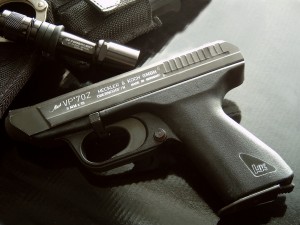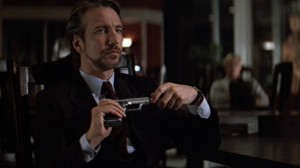This week details about H&K’s latest polymer striker-fired handgun have hit the gunternet and it seems to have people chatting quite a bit. I say “latest” here because many people don’t realize H&K actually made the very first polymer framed, striker-fired handgun in the world: The VP70. No, folks, Gaston Glock didn’t invent the basic Glock formula for “perfection”…H&K did. The VP70 is often forgotten because it wasn’t a commercial success for H&K. Aside from appearing somewhat ungainly, the VP70 was saddled with a very heavy trigger pull (18 pounds, if I remember correctly, heavier than most DA revolver trigger pulls) and a magazine latch in the heel of the pistol, features that have never gone over terribly well with American shooters.

The VP70 was designed to be considerably cheaper to manufacture than H&K’s other offerings at the time which included the magnificent P7 family of handguns. I happen to be a big fan of the P7 pistols because I spent some of my formative years seeing the New Jersey State Police carrying the P7M8 and P7M13 variants as their duty sidearms. The first time I saw one on the hip of a NJ trooper I remembered wondering where the rest of the gun was. It looked like they were just carrying the grip frame of a half assembled pistol to my young mind. Since I didn’t yet have 5 editions of Small Arms of the World I didn’t know anything about the P7 family of pistols and I sure as heck had never seen one in a gunstore before.
I hadn’t encountered one in a gunstore because the P7, like the VP70, wasn’t a big hit in the market. By all rights it should have been given the pistol’s compact size and brilliantly engineered squeeze-cocking safety system. Unfortunately all that brilliant engineering and being made out of high quality steel to high quality control standards resulted in a pistol that was extremely expensive. The ventricle-popping price of the pistols overshadowed all the good points of the guns (which have always had a reputation for reliability and durability) and kept them out of the hands of most police departments and regular joes. The price tag that made them a rare bird probably contributed significantly to the P7’s prolific movie career. If there’s a movie bad guy in a tailored suit odds are he’s packing a P7 of some sort because it just…fits. The look of the pistol, the compact size, and the rarely-seen-in-the-wild nature of the pistol all combined to make it a natural choice for the well-dressed sociopath.

The relative rarity of the P7 combined with the unique features of the pistol and plenty of screen time in blockbuster movies made the P7 into a legend. Few people have ever handled one or spent any time shooting one, but darn near everybody wants one because they’re just so darn cool. Hans used one, for Pete’s sake. The web is full of people who remember the legend and lament that H&K doesn’t make the P7 anymore, and some of them seem particularly upset that their new striker-fired offering isn’t a P7.
…but it can’t be. The P7 was ridiculously expensive to manufacture and while the compact size of the pistol was excellent from a carry perspective it achieved those dimensions with a gas-powered operating system that heats the gun up like a soldering iron when you put more than a few magazines worth of ammo through the gun in a relatively short period. My first real shooting exposure to the P7 family was during a 4,000 round handgun course where someone was shooting his beloved P7M13. Despite the heat shield those things got quite hot during that week. I say “those things” because he didn’t have a P7M13, he had four of them. He had to constantly rotate his pistols to keep up with the rest of us shooting something more pedestrian like my Beretta 92. When we shot on the reactive steel range, even with four pistols to rotate, he had to quit quite a bit before the rest of us because his pistols were simply too hot to hold anymore.
As much as I love the P7, they had some flaws and were entirely too expensive even in the pre-Glock world. Post Glock there’s absolutely no hope for them. Folks don’t seem to realize that Glock changed the entire firearms market. H&K made the VP70 because they were trying to find a way to put out a reliable handgun at a significantly lower cost. The use of injection-molded polymer for parts of the weapon and minimally machined steel for other parts were intended to make a (relatively) cheap gun that works. Glock took that formula and refined it. A Glock requires minimal machining for the major components allowing them to drop the per-unit cost of a pistol to such a low number that they could sell them cheaper than most other guns on the market and still make a tidy margin on each one. This is, in fact, one of the primary reasons why Glock took the law enforcement world by storm: They could sell guns at such a low price while still making a profit that they were able to offer sweetheart trade-in deals that got budget-conscious police administrators feeling dizzy. Throw in some snazzy demonstrations to get the troops over any objection to “plastic” guns and viola! Gaston Glock is worth almost 2 billion dollars.
H&K got back into the polymer game with the USP line of pistols and has expanded the lineup to the P2000, HK45, and P30 handguns…but none of them have been what you’d call cheap. Part of that is due to design, but part of it is also due to the way they insist on making guns. To the best of my knowledge they are the only mass manufacturer left who still makes all their parts in house. They have a very high level of quality control relative to other manufacturers in the business. They’re picky about the materials they use to make their guns. All of this is expensive and if you’ve ever wondered why an H&K sits on the gunstore shelf for $150+ more than comparable guns now you know.
The VP9 seems to be H&K’s attempt to find efficiencies in design that lets them drop the selling price of the pistol without sacrificing the way they make guns…and that’s to be commended because H&K actually seems to do a pretty good job of delivering a gun to the customer that will work reliably out of the box and for many thousands of rounds after that with little maintenance. They certainly aren’t perfect, but they seem to do a better job of it than many of their competitors. H&K can’t make the P7 anymore, but what they make today in the HK45 and the P30 are far better weapons by any objective measurement. If they’ve applied the same engineering know-how to the VP9 then odds are it will be a very reliable, durable handgun within the reach of most buyers in the market…and another good option for the consumer is a good thing.

i was lucky enough to run up on a 1981 non police trade in P7 in great shape in a pawn shop for $650 two months ago. its an awesome shooting gun. plan to run it in a USPSA match soon.
It’s been a couple decades since I worked a counter and shot a VP70; but as I recall, and without bothering to look, wasn’t the heavy trigger pull due to the pistol being designed with a detachable stock that enabled select fire, making it a patrol subgun in police use? Am I remembering a myth?
Have a VP70Z (Zivilian) model. The 18lb trigger is long, but smooth, and it’s capable of surprising accuracy. The M (Military) model was the one with the detachable shoulder stock which, when attached, gave 3 round burst capability. They were meant to be given to civilians (the Volks in Volkspistole) to fight the Russians when they came through the Fulda Gap. Not sure how effective it would have been against a T55 or a BTR, but it’s fun to shoot and an attention getter at the range.
Thanks Matt for the details.
I’m such a piker — only have the 1948, 1962, and 1990 editions of Small Arms of the World. . . [grin]
The 12th Edition was the only one recent enough to have info on the HK P7 and its West German police counterparts, the Walther P5 and SIG-Sauer P6 (P225).
I wanted a VP-70z for years, could have bought one in Germany years ago, at a US military gun store for $250…..don’t forget Tommy Lee Jones using a HK P7, or P13 in Under Siege….
The P7 is only one of a variety of HK’s that are desirable, not because they are especially practical for everyday use, but because they’re unusual and fun. The VP70 is another, along with the P9S and the HK4.